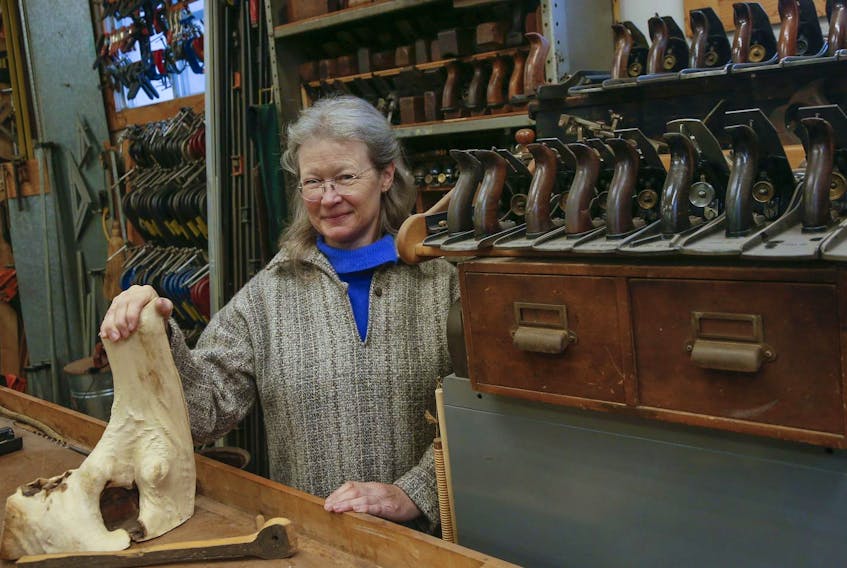DARTMOUTH, N.S. — One of Kate Langan’s two cats follows us into her modest home perched on a steep hill in Dartmouth not far from a steady stream of cars, buses and people passing by hospitals and a community college campus.
The large wooden workshop steps from the house’s main door, the roaring fire in the woodstove, and the white cat circling at your feet makes you feel more like you’re deep in the country, rather than on a city street. Everywhere you look in Langan’s house, there are books and wood. Beautiful pine floors, cedar doorframes, deep live edge cherry windowsills, wooden benches, chairs, ladders, bookshelves, and a stack of firewood piled by the stove. Langan deeply respects the natural material. Speaking about it sounds like a form of worship.
“When you get the chance to go to a place like Windhorse Farm (an old growth Acadian forest in New Germany) you see the trees. You choose your lumber and it’s dried there,” she said, while her cat curls its body by the nearby fire. “You’re part of the process of creating something. You’re part of the process of creating something beautiful.”
Langan’s love of wood and her desire to work with it by honouring centuries-old traditions led her first to wooden boat building and then to writing of her first novel, "The Grand Plan, A Tale of Romance, Crime and Boatbuilding."
Mining experiences she had building more than half a dozen wooden boats at the Maritime Museum of the Atlantic and the Nova Scotia Sea School, Langan crafted her first novel around Maria Kelly, an apprentice of a third-generation boat builder.
“I am passionate about Nova Scotia’s boat building heritage and wanted to write about a woman in such a non-traditional role. There are a few of us out there,” she said. “Traditional boat building was male dominated. I enjoyed flipping it around and having a woman boat builder.”
Tensions surface when Lloyd Naugle’s son, David, a land developer in Toronto, comes home to Nova Scotia with a grand plan, not to build boats with his father, but to pursue a real estate development that would change the shape of the small community. But before he can go ahead with his plan, he must persuade three people to sell him their land. Maria Kelly is one of them. She lives on her family’s homestead with sheep and rescue dogs.
“I am passionate about Nova Scotia’s boat building heritage and wanted to write about a woman in such a non-traditional role. There are a few of us out there." - Kate Langan
While David tries to get her to part with the land she loves, she tries to teach him the value of her rural lifestyle. In the village, people start questioning whether he is a good local boy corrupted by big city living, or whether he can still be trusted. Maria must also decide whether to keep her suspicions or let her growing feelings for him develop.
With boatbuilding at the heart of the book, The Grand Plan opens with an official launching party for a newly-built wooden vessel.
“Todays’ events epitomized the best of a boatbuilders’ life,” writes Langan in her self-published novel. “With the scheduled launch of one boat on the afternoons’ high tide, and the laying of the keel for another commissioned vessel, it represented the satisfied end and the hopeful beginning of work well done. In the past three generations, Naugle and Sons’ Boatworks had seen many such days, and although it was rarer now it still held a certain kind of magic. The difference today was that there was a cloud overshadowing the festivities.”
Langan’s own foray into boatbuilding was serendipitous. While working as a freelance writer more than 20 years ago, she went to the Nova Scotia Sea School for a story.
Founded as a charity in 1994, she wanted to find out how the school taught young adults to build boats and sail, while also instilling in them leadership, resiliency, environmental and community building skills. During her visit, she discovered they were looking for a boatbuilder.
She told her husband John, a journeyman shipwright.
He applied for the job and got it. She became his apprentice. By working alongside him, reading books and taking a week-long course where she helped to build a 16-foot wooden Norwegian pram, Langan learned the fundamentals of the traditional trade.
One of the most memorable wooden boats she built with the Nova Scotia Sea School was a 30-foot surf boat named Elizabeth Hall. A spritsail, ketch-rigged pulling-boat, it was modeled on the Sable Island surf-boats that used to transport people and gear from tall ships to the shores of the windswept island.
Growing up on Scotland’s northeast coast, near the city of Inverness, Langan was around boats all her life.
As a child, she remembers an old wooden boat sitting in the front yard. She eventually helped her father re-build it.
“That was probably where the seed was planted,” she said.

When she moved to Nova Scotia, following in her mother’s footsteps, she met her husband John, who grew up in Dartmouth. They stayed in his hometown and raised a son.
She worked for a time as a sailmaker and today still makes boat cushions for a local company. Along the way she also published an award-winning, non-fiction book called "The Art of Worship, The Vision and Craft of Contemporary Nova Scotian Artists" (Nimbus Publishing).
“If you’re not paying attention things can get lost,” she said. “We have to pay attention. I want people to think about paying attention to culture and old ways of life.”
The spark for Langan’s novel was ignited about 25 years ago while sitting with her husband at Halifax’s Trident Booksellers and Café.
“We were talking about how often old ways are bulldozed under by new developments, and how tragic are the losses of craft, knowledge, architecture and story as a result. I decided to write a novel about how a family copes with this conflict when it arrives at their doorstep,” she said.
After she retired from freelance writing in 2008, she picked up the idea for the novel again and started working diligently.
Most evenings after dinner, she sits at her desk, an almost two-metre long, white mahogany table that John built, with her laptop computer.
Perched on a beautiful stump of wood beside her are some of the playful, woollen felted creatures she creates and sells. Her two cats often sit on her lap or sleep on a mat beside her computer.
Most evenings after dinner, she sits at her desk, an almost two-metre long, white mahogany table that John built, with her laptop computer.
When she’s not writing, the table turns into her sewing space. Colourful balls of wool piled in shelves line a wall behind her desk. Writing for Langan is as much about editing and re-writing. She estimates she edited The Grand Plan as many as 15 times. After she completed it, she put it aside for a year.
“To let things cool so I could go back to it with fresh eyes,” she said.
When it was time to publish, she asked her son Cameron Ax, a painter who also works in animation, to help design the book’s cover. She researched self-publishing companies and chose Smashwords. Her children’s e-book called Beulah in Bethlehem is also available through the e-book publisher.
“I got to be in charge of the whole thing from start to finish,” she said.
She later reformatted her book and relaunched it as a trade paperback through Blurb. It is now available in all electronic formats and as a paper book.
The act of taking a book off a bookshelf, sitting by the fire with her cats and reading is not only a deep pleasure for Langan, but a tradition she doesn’t want to lose.
“I still prefer to hold a book. I love the feel of the cover and the smell of the paper, and the fact that it’s easy to check back on something you read earlier because there is a memory of where in the book the passage you are seeking is located.”









